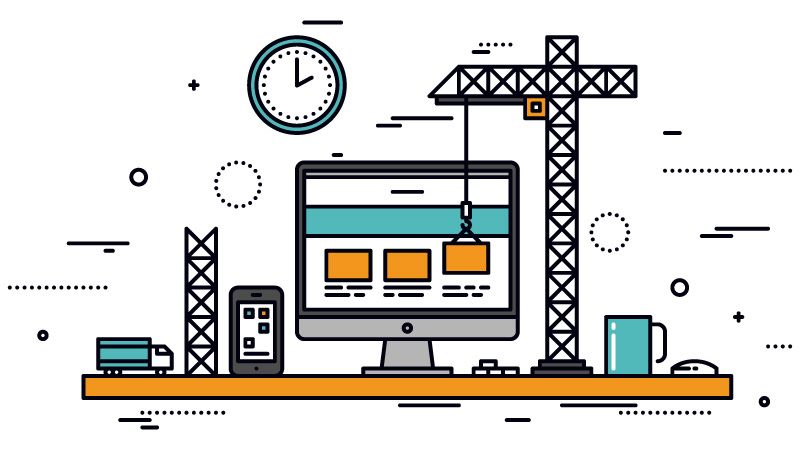
5 Tips For The Website Redesign Process
Love ’em or hate ’em, website redesigns are a must for any organization that wants to generate leads online.
In an ideal world, your company would run through the website redesign process every few years. After all, a few years on the web is the equivalent of decades in the real world. Outside of updated aesthetics, you’ll also want to implement new web technologies, address usability oversights, and make webpage content even better.
If you want your next websiteto achieve your company’s digital goals, make sure you rememberthese 5 website redesign tipsduring the proposal process.
Redesign Tip #1: Don’t Ignore Mobile Compatibility
Businesses can no longer ignore mobile designsupport for their website(s). It needs to be a primary objective during yourredesign project. Mobile device usage has skyrocketed in recent years, with mobile activityoutpacing desktop activitysince the start of 2015.
Additionally, Google is nowusing mobile-friendliness as a ranking factor and have been penalizing sites with poor mobile experiences. So if you want your website to show up in Google searches, you need to make it mobile-friendly.
It doesn’t matter if 10% or 50% of your visitors are coming from mobile.
Mobile devices and browsing isn’t going away. In fact, mobile traffickeeps growing while desktop traffic is starting to shrink. Take a look at the decline in desktop search queries over the past year here. By ignoring mobile compatibility during the websiteredesign process, you are putting your company’s digital futureat risk.
What are my options?
When it comes to mobile compatibility for a website, you really have 2 options.
- Build a responsive website
- Create a separate mobile website
Responsive websites are widely considered the best approach to mobile compatibility for the web. But in some cases, a separate mobile website is a better option. You can read this blog post to help you figure out what’s the bestoption for your company.
Conclusion
You will be beating yourself up in less than yearif you choose a website redesign proposal that ignores mobile. We can promise you that. Even if your approach to mobile compatibility is a separate website, you need to havesomething to offeryourrapidly growing mobile audience.
If you want to learn more aboutGoogle’s mobile website penalty and what we suggest for mobile-friendly websites, you can read this blog post about responsive website design.
Redesign Tip #2: Beware ofCustom Content Management Systems
This section isn’t intended to bad mouth agencies who use their own content management system (CMS) for their clients, it is intended to educate the potential buyers of what the risks are.
Some agencies create their own content management systems from scratch instead of using widely adopted systems like WordPress, Drupal, or others. An agency might migrate your website to a proprietarysystemto make your companydependent on theagencyfor ongoing development work. It’s a dirty tactic that many businesses overlook during the website redesign proposal process.
More often than not, migration to a custom content management system isn’t necessary for awebsite redesign. A solution can typically be provided by customizing an open source CMS such as WordPress. The idea is, why reinvent the wheel?
If an agency or freelancer is pitching you a custom CMS you should ask them the following:
- Why can’t we use an open source system?
- What documentation do you have available for this CMS?
- In the event of contract termination, what does the off-boarding process look like?
- Do we have access to the CMS filesystem and database if needed?
If the agency or freelancer doesn’t have documentation or doesn’t have reasonable answers to the above questions, proceed with caution. For enterprise-level website redesigns, this type of solution is harder to avoid because of the limited corporate CMS options available.
Conclusion
Keep your ears and eyes open during website redesign presentations and RFP processes in regard to the what CMS the freelancer or agency is suggesting. If you aren’t sure of the CMS then you should ask the questions above and/or get a second opinion from a competing agency.
Redesign Tip #3: AvoidPre-Built Themes or Templates
Pre-built CMS themes or templates often seem like a great idea during a website redesign process. They boast plenty of features, can cost less than custom theme/template development, and they often look good enough — especially for smaller businesses.
You can find these types of pre-built themes on websites like:
- themeforest.net
- envato.com
- templatemonster.com
- and countless others.
So why should you avoid them?
The general idea of a pre-built theme or template is well intended. Unfortunately, these “swiss-army-knife” themes come with more negative qualities than positive ones.
The main problem is that pre-built themes typically enable 100% of the available features on every webpage, yet most businesses only use a fraction of them. Having unnecessary features enabled can cause severe page load times, code-bloat, and often times security vulnerabilities.
We have inherited many client websites who chose to use premium themes or templates. More often than not, we have had to do more work repairing the damage than actually helping these clients meet their marketing goals.
Alternatives to pre-built website themes.
If you are really hell-bent on using a template to jump-start a new website design and reduce development costs, use a website like wrapbootstrap.com or foundationdeck.com. These websites offer templates with many features, however – they are provided as plain HTML/CSS/JS files instead of packaged as a pre-built CMS theme.
A skilled developer or agency (like us) can take a template from above and fine-tune it to include only what you need. The result will be a much faster and and more custom tailored website for your business.
Redesign Tip #4: Falling into the Plugin / Module Trap
The “plugin problem” isvery similar to ourprevious website redesign tip. While plugins and modules may cut down on development time and offer instant upgrades, they can slow your website down and create issues for search engines.
With site speed becoming anincreasingly important ranking factor for Google and other search engines, you should use as few plugins or modules as possible.
Poorly developed plugins / modules WILL slow your site down.
Plugins and modules are small pieces of additional software that extend the default functionality of a CMS. Therefore, a poorly written module or plugin can slow your entire site down to a crawl,. Or even worse, they can expose your website to security risks.
So for each plugin / module you install, you are essentially trusting the developer of that plugin/module with your sites speed and security.
From our experience the biggest culprits areplugins / modules that provide the following:
- Social Sharing Buttons / Icons
- Images Sliders or Photo Galleries
- Advanced Dropdown or “Mega Menu” functionality
Simple functionality such as social sharing can be easily installed inside a theme templates where they are needed. This keeps load times faster for pages that don’t need to use the social sharing functionality.
Conclusion
I personally try to keep the WordPress sites I develop to under 15 plugins. Try to limit plugin usage for major functionality changes such as events calendars or creating and managing form submissions. If you are a small business or start-up a small amount of capital, pre-built templates can be a good starting point but you’ll want to do your homework before making a decision.
Redesign Tip #5: Don’t Use Stock Photography
While convenient, stock photography is not the answer to a websites imagery needs. With web trends using more large background imagery and video, stock photography can often be spotted quickly especially when looking at websites in the same industry. Just look at the top 10 internet marketing companies websites in your area to get an idea.
Stock photography is more acceptable for higher funnel content such as blog articles. But whenever possible, and especially for lower funnel content like service pages, custom photography should be used to differentiate your website from your competitors. Made By Magnitude has a great article about stock photography and how it can negatively impact your brand.
If you must use stock photography try the following tips:
- Choose images that aren’t immediately noticeable as stock photography. Stay away from business meetings or people pointing at computer screens.
- Modify the stock photos or combine multiple photos to make them more unique. This requires some photoshop skill but it is worth the effort.
- Stay away from budget stock photo websites because you get what you pay for.
- Keep stock photos face-free. Stock photography modeling is an exclusive club so the models are easilyidentifiable.
Honorable Mentions
The items below didn’t make themain list, but they are definitely worth avoiding:
Budget Hosting
Budget hosting such as GoDaddy isn’t viable for a serious business. With site speed becoming a more important ranking factor, your website redesign project plan needs to use something better suited for businesses.
Adobe Flash
Mobile devices don’t support it, and it’s an antiquated technology. It is time to leave Adobe Flash in the dust.
Flash has been blocked a hand full of times over the past year due to security vulnerabilities with the software. If you are still relying on flash for any web-content, now is the time to get a migration plan in place.
Inept Digital Marketing Agencies
Make sure your agency or freelancer knows how to handle 301 redirects and carry over SEO metadata from the old to new website. If they don’t you can expect a bad surprise in your website traffic reports.
Final Conclusions
We have seen clients come and go over the years and you wouldn’t believe the scenarios we have encountered from botchedredesigns. Keeping these items in mind when communicating throughoutwebsite redesign RFP process or presentation will help you quickly identify major redesign mistakesand avoid them.
If you have any questions during a website redesign process, youcan give us a call or send us an email, or click the button below to request more information.
Most newsletters suck...
So while we technically have to call this a daily newsletter so people know what it is, it's anything but.
You won't find any 'industry standards' or 'guru best practices' here - only the real stuff that actually moves the needle.







